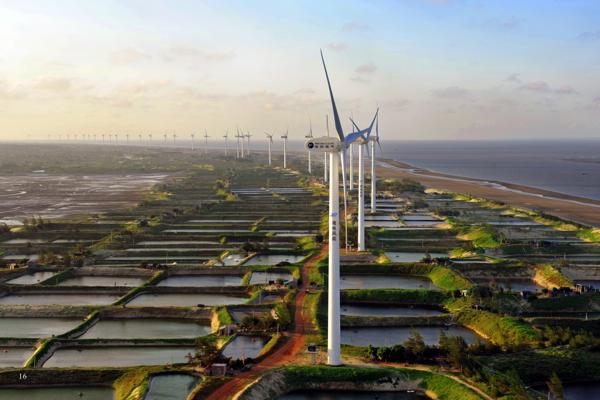
A huge wind farm in Xuwen, Zhanjiang, represents the city’s new orientation in developing environmental-friendly industries.[Photo/Provided to China Daily]
Construction on the Zhanjiang Economic and Technological Development Zone is making good headway, with its major projects in steel, petrochemicals and papermaking on schedule, said local authorities.
Expected to become a new economic engine for Guangdong, the zone is playing a big part in accelerating the economic development in western part of the province.
According to its development plan, the zone is expected have annual industrial production worth more than 300 billion yuan ($48.78 billion) in five years and more than 500 billion yuan in a decade, entering into the top 10 development zones on the Chinese mainland.
The zone is home to a mega iron and steel plant and a petrochemical project on Donghai Island, the fifth largest island in the country and the biggest in Guangdong.
Construction on the iron and steel project by Baosteel Group is planned for completion in September 2015. It will have an annual production capacity of 10 million tons of steel.
More than 17.49 billion yuan has been invested to date in the project, 11.6 billion yuan of it this year.
The zone’s Sino-Kuwaiti petrochemical facility will be able to refine 15 million tons crude oil and produce more than 1 million tons of ethylene a year when operations begin by the end of 2016. Some 2.77 billion yuan has been invested to day, 2 billion yuan of it in 2014.
Steel, petrochemicals and papermaking will become pillar industries in Zhanjiang, playing a big part in the city’s economy in the coming years, local authorities said.
To support the industries, the city government has plans for 50 sq km in petrochemical projects, a 30-sq-km industrial park for the iron and steel industry and another 20 sq km for papermaking.
Construction on a new airport will begin in 2015 and will be completed in 2017 to help further improve the city’s infrastructure and investment environment, local authorities said.
Liu Xiaohua, Party chief of Zhanjiang, urged the government to speed up construction of the zone in the following months.
Liu and Zhanjiang Mayor Wang Zhongbing recently visited the zone and promised to continue to introduce even more incentives to support development and help attract foreign investment.
Protecting ecology
Wang told government departments to pay special attention to protecting local ecology.
“Economic growth cannot be achieved at the cost of the ecology and environment,” Wang said.
“Zhanjiang’s environment and air quality will remain intact after the petrochemical project begins operation,” he added.
In addition to further simplifying administrative procedures, the city government will continue to introduce a series of preferential policies to encourage foreign companies to invest in the zone, the mayor said.
Covering an area of more than 496 sq km, the zone includes the city’s Donghai, Naozhou, Dongshantou and Nanping islands.
It is now home to more than 2,500 foreign-funded companies. Investors have come from North America, Europe, East Asia, Northeast Asia, the Middle East, as well as Taiwan and Hong Kong.
Big-name foreign companies including Coca Cola and PepsiCo have set up production facilities in the zone.
In addition to steel and petrochemicals, local authorities particularly want more foreign companies to establish production facilities in high-tech, papermaking, ocean-derived biomedicines, machinery, garments, electric appliances and beverages.
Located on Guangdong’s Leizhou Peninsula facing Hainan Island, Zhanjiang has abundant resources in agriculture, aquatic production, tourism, minerals, crude oil and natural gas.
It is a major sugar cane production and seafood export center.
In 2010, the zone was rated as a province-level high-tech zone and a province-level development zone for recycled economy.
In 2011 the zone was listed by the provincial government as an important destination for the industries transferred from the Pearl River delta region.
